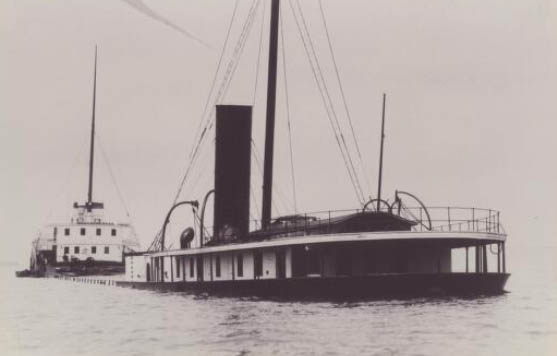The SS Senator was a steel-hulled Great Lakes freighter that sank on Lake Michigan on Halloween, 1929, with the loss of nine lives and 268 Nash automobiles after being rammed by the bulk carrier Marquette in heavy fog. She lies in 450 feet (140 metres) of water, about 16 miles northeast of Port Washington, Wisconsin.
The Detroit Dry Dock Company of Wyandotte, Michigan built the S S Senator in 1896. Her hull measured 420 feet (130 metres) overall, 410 feet (120 metres) between her perpendiculars, 45.6 feet (13.9 metres) wide, and 28 feet (8.5 metres) deep. Her gross register tonnage was 4048.75 tonnes, and her net tonnage was 3178.66 tonnes. She was propelled by a 1,450-horsepower (1,081 kW) triple expansion steam engine fed by two Scotch marine boilers that burned coal.
Senator‘s launching from the newspaper Marine Review
“Matters in the ship yard of the Detroit Dry Dock Co. at Wyandotte are being arranged for the launching of the big steel steamer Senator on Saturday, the 13th. The Senator is one of the steamers of the 400-foot type and will be owned by the Wolverine Steamship Co., of which John B. Roby is president and in which Senator McMillan and other stockholders of the dry dock company are interested. The steamer will be managed by Capt. M.W. Humphries. She is 420 feet long over all, 400 feet keel, 45 feet beam and 28 feet deep, and will be propelled by a triple expansion engine with cylinders 22, 35 and 60 inches in diameter by 44 inches stroke. It is expected that on 16 feet draft she will carry about 4,800 gross tons of ore and that with this load her engines, which are of 1,400 horse power, will drive her at the rate of 13 miles an hour. A feature in this boat is a patent anchor in the extreme stern. This is to be used in case of emergency in the “Soo” river and other narrow channels when through current or the influence of a passing vessel control of the big steamer is lost and she begins to swing so as to bring her into dangerous proximity to another boat or to a rock or dock. She will carry one smokestack, two short spars forward of this, will be fitted with Howden hot draft, and will have a complete electric lighting plant, search light, full handling equipment, telephones to connect the master or pilot with distant parts of the ship, etc. Alike to other big coarse freight carriers of her kind, she will have no deck house or in fact anything between the boiler house and texas excepting the deck engines. The Senator will be sailed by Capt. H.B. McQueen.”
Marine Review June 11, 1896
The SS Senator loaded 224,000 bushels of corn at Milwaukee, Wisconsin in 1898, which had one of the largest cargoes loaded at that time.
Senator became stranded on Ballard’s Reef near Detroit in June 1898.
Senator was struck and sunk by the steamer Norman B. Ream off Pipe Island in the St Marys River on August 21, 1909, in what was possibly the most significant incident in her career prior to her sinking. When the Norman B. Ream ripped a large hole in her starboard side, her crew had barely enough time to run her through the middle ground before her hull filled with water.
Senator loaded 224,000 bushels of corn at Milwaukee, Wisconsin in 1898, which was one of the largest cargoes loaded at that time. Senator became stranded on Ballard’s Reef near Detroit in June 1898.
Senator was struck and sunk by the steamer Norman B. Ream off Pipe Island in the St Marys River on August 21, 1909, in what was possibly the most significant incident in her career prior to her sinking. When Norman B. Ream ripped a large hole in her starboard side, her crew had barely enough time to run her through the middle ground before her hull filled with water. Senator was raised and taken to a dock on September 12, 1909 and towed into the port of Cleveland, Ohio, on October 6, 1909. The following day, she was towed to Dry Dock for $90,000 in repairs. She was out of commission for the remainder of the shipping season.

SS Senator’s Final Voyage
Senator, commanded by Captain George Kinch, was transporting 268 Nash automobiles (worth $251,000) from Milwaukee, Wisconsin to Detroit, Michigan on October 31, 1929. Meanwhile, the ore carrier Marquette, commanded by Captain W.F. Amesbury, was carrying iron ore from Escanaba, Michigan to the steel mills of Indiana. The two ships collided, and Senator was destroyed in 8 minutes. Several members of the crew jumped into the water, while others were able to board the Marquette. 15 men were rescued from the lake by a tugboat. Seven members of the crew of 28 died.
On June 10, 2005, a Klein 531 side scan sonar was used to pinpoint the Senator’s exact location. The wreck site is 430 feet deep (130 m), well beyond the average diver’s range for visiting.







